|
|

Sellers' Corner
Walter Shawlee 2, Kelowna, BC, Canada
The Slide Rule Universe
Strange Variations
One of the real delights of slide rule collecting is to suddenly come across a seemingly familiar rule that is strangely and unexpectedly different. This can take a lot of forms, from special packaging (moon flight marked Pickett boxes, or 100th anniversary marked Aristo boxes) to completely bizarre, one-of-a kind factory prototypes. There are also the thousands of specially marked Sama and Etani circular rules, each made for a specific customer as a company promotion, and endless production variations. The champion of variation, of course, remains the world of slide charts and Perrygrafs, where hundreds of thousands of design exist, many far more complex than regular solid body slide rules. Annual production of these today remains at about 6 million units. (Fig. 1)
Many manufacturers also made cosmetic variations for customers, with logos added, different colors to match corporate color schemes, imprinted cases and rules, and similar changes. These subtle differences add some real interest to collecting, as they exist outside all the catalogs and references, and just appear at random in the rule population.
Every major rule also had some production variation in its lifetime, changing cursor styles, modifying scales and scale marks, plus color and style changes that often completely altered the rule’s appearance over time. Just collecting all the changes and variations of the venerable K+E 4081 series and its eventual models and sizes can fill up a large collection. Faber Castell had some of the most interesting rule changes, often completely re-designing some key rules over time, so that each new rule example showed their best art at the time, only to be replaced by even more ingenious examples along the way. The body and scale variations of the FC 2/82 and 2/83 family from pocket to full sized rules is an especially rich selection, full of wonderful rules, and some amazing evolutionary changes.
Some years ago, I bought a few boxes of “surplus” partially completed and bulk packed rules left over from the closure of the Pickett factory in Mexico. One box contained a host of surprises, including mis-marked rules (T marked yellow body rules), experimental end braces in several styles on common rule types, and a strange hybrid aluminum and plastic rule. (Fig. 2) Talk about a bonanza of strange discoveries! There were even a few green body rules from Pickett, a very uncommon factory variation they made for a few customers.
No matter how many rules we see, there is always something that is new and unexpected. This month, I got a new Faber Castell 63/83 that caught my eye because it was colored green instead of the regular red that all the 63/ series pocket rules have been so far. (Fig. 3) It has the green braces and green stripes that were on all the full sized FC plastic rules like the 52/82. What does this mean? I have no idea, was it an early type, changed for some marketing reason, or custom made? I just don’t know, but visually, it’s amazing. Years ago, I got a K+E Deci-lon that had a factory green case, not the normal orange sewn leather case. It had the Deci-lon logo and everything, but was made of the cheap composite case material. I have never seen that variation shown anywhere or found another since, so it remains one of those enjoyable moments of discovery that makes collecting especially interesting.
No matter what your area of slide rule interest is, if you look a bit deeper, you will find the hidden pattern of variations that followed every maker and model. Paul Ross and Ted Hume in their landmark Post Catalog article found that the ubiquitous “Versalog” from Post was really a family of rules, with several subtle variations, and originated as a very rarely seen Hemmi 258. You can see their research efforts here: http://www.sphere.bc.ca/test/post.html
So, my advice is to look a bit deeper, and see what you can discover for yourself. All for now, and the best of luck in the hunt.
Walter
walter2 “at” sphere.bc.ca
The Slide Rule Universe
|

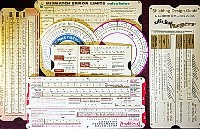
Fig. 1 - Slide Charts

Fig. 2 - 'Hybrid' Pickett
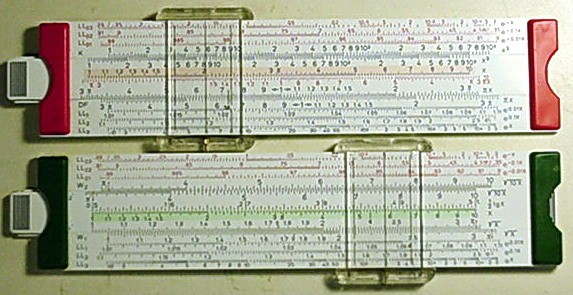
Fig. 3 - Faber Castell 63/83
|
The Beginning Collector - Early American Slide Rules - Part II
Kate Matthews, Sonora, California
No sooner do you make any kind of generalized observation, then someone instantly shows you the exception to your rule. In the last issue of our Bulletin, I made the observation that one could generally distinguish between early slide rules imported from Europe but branded as American, and those actually manufactured in American by looking for the presence or absence of the upper horizontal line on the scales. In general, European slide rules had ‘em and American made slide rules, following K+E’s lead, did not.
After the column appeared Clay Castleberry sent me some intriguing pictures of the celluloid laminate on his K+E 4041 and asked me to opine about the origins of the rule.
At first, I was of the opinion that that Clay’s rule was likely to be another example of a Dennert & Pape import, with overbranding by K+E.
Then Clay sent me the scans of the four K&E slides. (Figures 2 & 3.) The scans show four Keuffel & Esser branded slide rules. As seen from top to bottom those models are 4041, 4040, 1746, 1746
Upon reviewing the photos, it is pretty clear to me that the upper two rules were both made by K+E, while the lower ones were made by Dennert & Pape. Clay’s 4041, though it sports European style scales, was clearly made by K+E. It has the characteristic mahogany body that it notably darker than its earlier made European counterparts. The 1-sided Mannheim style body stock, with its characteristic screw placements, rounded constants table label and its smoothly rounded notches should be familiar to all K+E collectors as it endured for many years on virtually all of K+E’s many variations of the Mannheim style rule.
Clay’s 4041 bears the characteristic patent date marking, proving that it was manufactured sometime after the patent was issued on June 5, 1900. In my mind, it was clearly manufactured by K+E, but must be one of the earliest rules they made. The rule shows other indications of early production, which Clay and I will discuss in further detail in an upcoming JOS article.
Many thanks Clay for sharing a very fascinating slide rule!
|


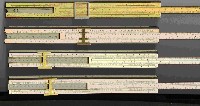

|
A SMALL COLLECTION OF AVIATION NOVELTY SLIDE RULES
Clay Castleberry, Oroville, California
This is not an article about the “Small”, cylinder slide rule featured in Volumes 1.-1 and 1-2 of the Oughtred Society Journal. It is about a small group of specialty rules, which were mildly popular with collectors with an interest in aviation, probably during the 1950’s and 1960’s.
Figure 1 illustrates the variety of rules available in this group. The top row shows three different money clips. The middle money clip rule also incorporates a combination knife blade and fingernail file. In the middle row on the left, are a key chain, a tie tack and a cigarette lighter on the right. The reverse side of the lighter which is shown in Figure 2, features a perpetual calendar, with dates from 1950 to 1977, indicating circa 1950. In the bottom row of Figure 1 are the cuff links that go with the tie tack. All have black faces.
The fixed outer and rotable inner scales are adaptations of the standard linear C & D slide rule scales to solve the basic time-distance-speed problems of aviation. They are based on the computer originally designed by Lt. Philip Dalton in 1931. Dalton’s original design evolved into the famous EB-6 flight computer of World War 2. The scales of course can be used for non-aviation applications as well. The outer scale of one of the money clips and the keychain also include the proper location of pi. Wth the exception of the latter two which were made in the U.S., the others were made in Japan.
The scale diameters range from 0.75” to 1.0”, giving a longest scale length of 3.14” indicating a low degree of accuracy. One would be led to believe that these were given as favors, rather than for the more serious use of flight related calculations. They were probably not big sellers as none have a maker’s name except for the lighter signed, “Chadwick.” They soon disappeared from the slide rule scene. No doubt there are other examples to be found of these small circular slide rules. One, recently brought to my attention, is a tape measure with aviation scales similar to the those in my collection with the tape scaled in statute miles.
Figure 3, shows the money clip with the combination knife blade and fingernail file. The owner may well have been a private pilot who today certainly wouldn’t be carrying one on a commercial flight.
While these rules are not special, they do make an interesting display by themselves, albeit a small one.
|

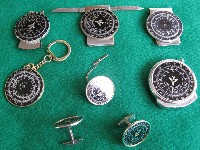
Fig. 1 - Aviation Novelty Slide Rules.
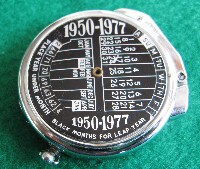
Fig. 2 - Reverse Side of Lighter.
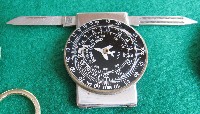
Fig 3 - Money Clip w/ Knife & Fingernail File.
|
My Favorite Slide Rule
John K. Emmons, Palacios, Texas
I have graciously been given the opportunity of writing a paragraph or two on what I would choose as my favorite slide rule. To give some background, I have been a slide rule collector for a while now, for which my wife is to blame, but that is another story. In my younger days I used a Pickett N803-ES, which I still have, in my work as a mechanical design draftsman, but dropped its use completely in lieu of a standard calculator until I started collecting again.
I now use several slide rules for different needs. Some of my favorites are the Hemmi 260, the 10” Nestler MultiMath and several models made by Aristo. My very favorite slide rule is probably not an obvious choice. It is the very plain 6” Veb Mantissa Multi pocket slide rule. I carry this rule in my shirt pocket and use it at work every day. It seems to fit my eyes and hands just right. I don’t have to ‘hunt’ for scales like I do on some other slide rules. The scale layout and color scheme are perfect for my calculation needs, which consist mainly of trigonometry calculations and standard arithmetic operations. As can be seen in the scans, Log and Log Log scales are on the back of the slide which suits me just fine as I very rarely have a use for these functions. I use the ‘A’ scale for standard squares and square roots and have not missed the ‘B’ scale at all. The cursor is not original and was constructed from a section of 6” clear acrylic pipe. The original cursor had three hairlines; my homemade one has only one. It has been dropped, chipped, drowned and sat on several times. Even though it is scratched, the numbers are still quite clear. The fit, finish and tolerances of the Veb slide rules seem to be a cut above other manufacturers and there is no noticeable gap between the slide and body even after much abuse at my hands. While I am tempted by the siren song of others, I always come back to this one.
Thanks for the opportunity to comment on this subject.
|

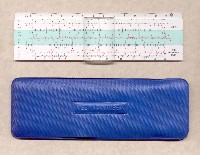
Fig. 1

Fig. 2
|
|
| |
|
|